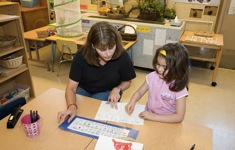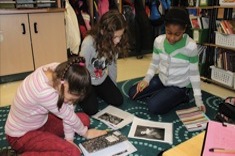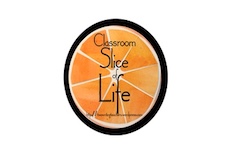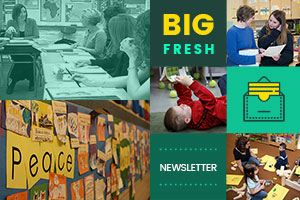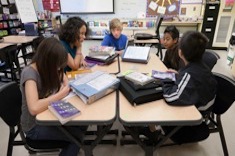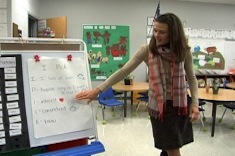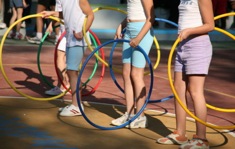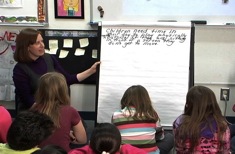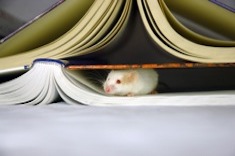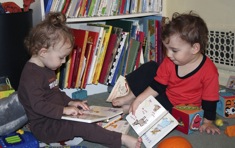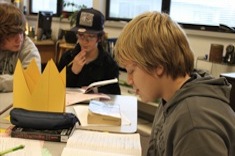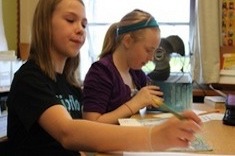Library
Choice Literacy Articles & Videos
The Choice Literacy library contains over 3,000 articles and 900 videos from 150+ contributors. Classic Classroom and Literacy Leadership subscribers have access to the entire library. Content is updated continuously, with five to six new features published each week.
Latest Content
The Lunch Lady and Gender in Reading
Franki Sibberson has her students read a blog post about books written for boys and girls, which begins a fascinating discussion with the class about gender in reading choices.
Keeping Track of Questions
Andie Cunningham observes a third-grade teacher as she systematically improves the quality and depth of student questioning over time.
Three Ways to Build Purpose in a Preschool Reading Workshop
Melissa Kolb finds her three- and four-year-old students are ready for more focus during reading time.
Shared Reading in the Intermediate Grades
Shari Frost explains why shared reading is valuable for older students, with examples of the practice in the intermediate grades.
Slice of Life: Challenging Student Writers
Katherine Sokolowski brings the popular web “slice of life” challenge to her fifth-grade classroom.
The Big Fresh April 27, 2013 Stories
Shared reading is the focus of this week’s Big Fresh.
The Big Fresh April 20, 2013 Data Trouble
We explore the balance of choice, independence, and structure in this week’s Big Fresh.
Assessing Learning During Student-Led Book Clubs
When middle school students have choice and independence in book clubs they lead themselves, how do you assess their learning and thinking? Katie Doherty provides a variety of question prompts she uses with groups to spark reflection on learning.
10 Principles for Planning Reading Minilessons
Franki Sibberson shares 10 principles for minilesson planning. This is an excerpt from her new book, The Joy of Planning.
Symbiosis: Choice and Structure in Writing Workshops
Ruth Ayres and Heather Rader draw on their work as literacy coaches and teachers to explore the complex connections between choice and structure in writing workshops.
Guidance and Choice in a Fifth-Grade Conference
Karen Terlecky confers with fifth grader Jillian the day after she has selected two books Jillian might enjoy reading during workshop.
Kindergarten I-Pick Minilesson
It’s never too early to help students learn to make wise choices for independent reading. Mandy Robek reviews the I-Pick strategy for choosing appropriate books with her kindergarten students.
Between the Brain and Page: Working with Gifted Student Writers
Michelle Kelly explains how gifted student writers have needs that vary greatly. "Carolyn the Voice," "Alan the Verbose," and "Bailey the Perfectionist" are all gifted writers who need different workshop structures and guidance to do their best work.
The Big Fresh April 13, 2013 Rename It
Innovative use of audio books is the topic of this week’s Big Fresh.
Understanding the Middle East Through Children’s Literature (BOOKLIST)
Sheiks, harems, and terrorists — the stereotypes of the middle east from popular culture may not be realistic, but they sure are pervasive. Ruth Shagoury and Andie Cunningham find authentic alternative views to present to children in their new booklist.
Every Picture Tells a Story
Max Brand describes how he uses images to build reading and writing skills among his kindergartners.
Research IS the Project (Primary Research Series)
Heather Rader blurs the line between research and presentation in the final installment of the primary research series.
Embracing the Growth Mindset with Audiobooks
Jennifer Vincent explains how recorded texts were a potent tool for reaching a struggling fourth-grade reader.
Audioboo, QR Codes, and Authentic Reading Response
Katherine Sokolowski uses audio recordings and other tech resources to build her fifth-grade reading community.
The Big Fresh April 6, 2013 Thanks
This week’s Big Fresh is focused on family literacy outreach.
Teacher-as-Writing-Model Minilesson in Fourth Grade
Beth Lawson models her process as a writer for her fourth-grade students, describing her emotions as well as creating a draft.
KLWL: Ordering Research (Primary Research Series Part 3)
Heather Rader looks at the importance of frontloading information for young learners in the third installment of the primary research series.
Tips for Effective Family Communication from “The Mouse”
Jennifer Vincent details strategies and shares survey templates she uses in reaching out to families.
Family Literacy Night
Family Literacy Nights have become popular in many schools. Principal Jennifer Schwanke describes the format for a successful event, including a sample program and tips.
A Literary Taste of Home (Home is Where the Books Are Series)
Meghan Rose may live in Los Angeles, but the home of her heart will always be New England. In this booklist, she shares her favorite picture books about everything from the Red Sox to Maine blueberries to give her children a sense of where she grew up.
Hindsight: What I Wish I’d Known Before My School Burned Down
Melanie Quinn shares lessons from the fire that burned down her school.
The Big Fresh March 30, 2013 Appreciation
This week’s Big Fresh features resources for the start of National Poetry Month.
Just-Right Poetry and Individualizing Instruction
Shari Frost describes how a sixth-grade teacher provides a range of poetry options to meet the needs of all students.
The “Tys” of Student Research: Safety and Credibility (Primary Research Series Part 2)
Heather Rader shares the second installment in our primary research series.
March Book Madness
Basketball’s March Madness has many possibilities in schools. Tony Keefer tries a similar format with brackets and voting for March Book Madness.
Browse Content By
Type
Category
- Assessment Tools
- Big Fresh Archives
- Booklists
- Choice Numeracy
- Classroom Design
- Common Core
- Community Building
- Conferring
- Content Literacy
- Digital Literacy
- English Language Learners
- Equity
- Family Relations
- Free Samples
- Guiding Groups
- Leadership
- Literacy Coaches
- Mentor Texts
- Minilessons
- New Teacher Mentors
- Podcasts
- Poetry
- Quote Collections
- Reading Strategies
- Self Care
- Struggling and Striving Learners
- Talking and Listening
- Teacher Study Groups
- Teaching Reading
- Teaching Writing
- Word Study and Vocabulary
Author
- Melissa Quimby
- Nawal Qarooni
- Gwen Blumberg
- Julie Cox
- The Lead Learners
- Hannah Tills
- Josie Stewart
- Ruth Metcalfe
- Mallory Messenger
- Becca Burk
- Jodie Bailey
- Vivian Chen
- Mary Brower
- Tiffany Abbott Fuller
- Stephanie Affinito
- Ruth Ayres
- Leigh Anne Eck
- Heather Fisher
- Shari Frost
- Julie Johnson
- Suzy Kaback
- Gigi McAllister
- Shirl McPhillips
- Melanie Meehan
- Cathy Mere
- Debbie Miller
- Tara Barnett and Kate Mills
- Tammy Mulligan
- Dana Murphy
- Bitsy Parks
- David Pittman
- Brenda Power
- Heather Rader
- Matt Renwick
- Mandy Robek
- Christy Rush-Levine
- Gretchen Schroeder
- Jen Schwanke
- Brian Sepe
- Katherine Sokolowski
- Stella Villalba
- Jennifer Vincent
Grade Level
Choice Literacy Membership
Articles
Get full access to all Choice Literacy article content
Videos
Get full access to all Choice Literacy video content
Courses
Access Choice Literacy course curriculum and training



